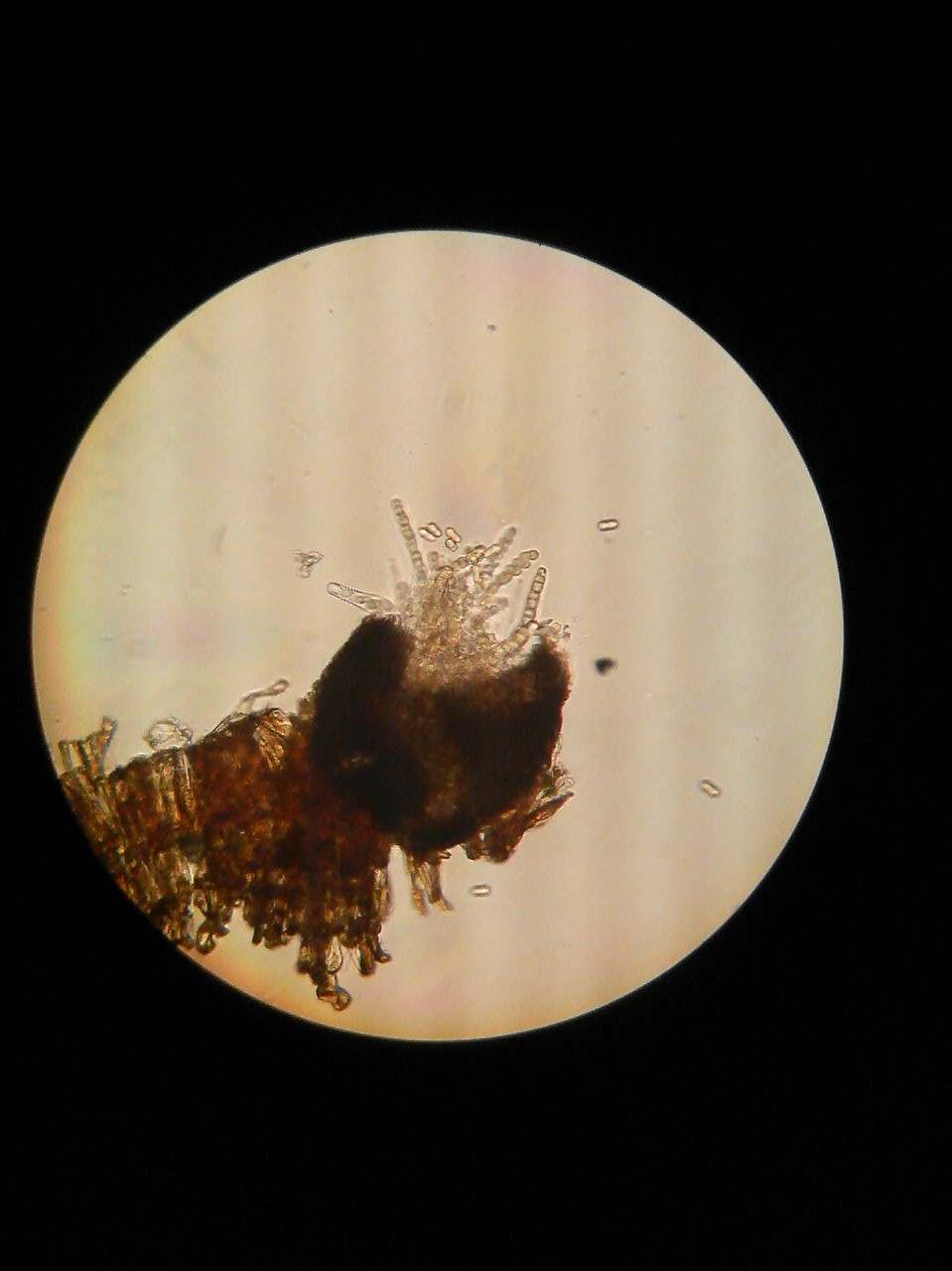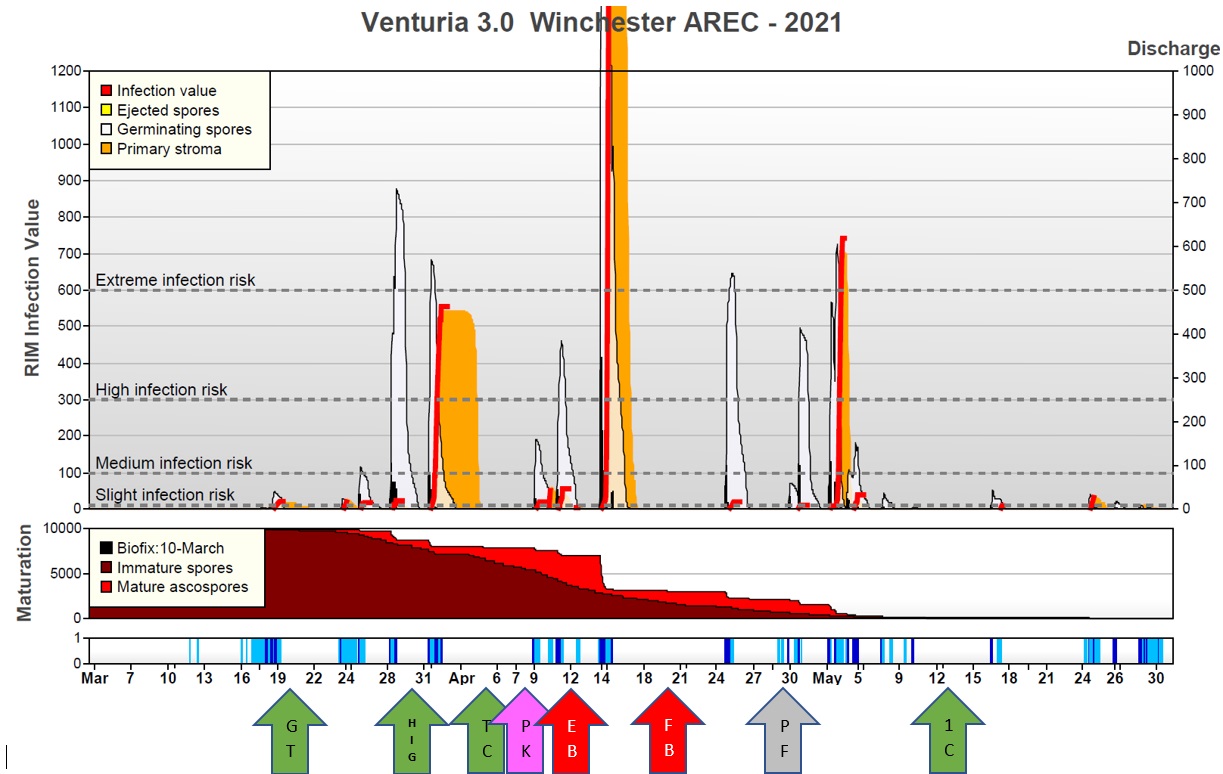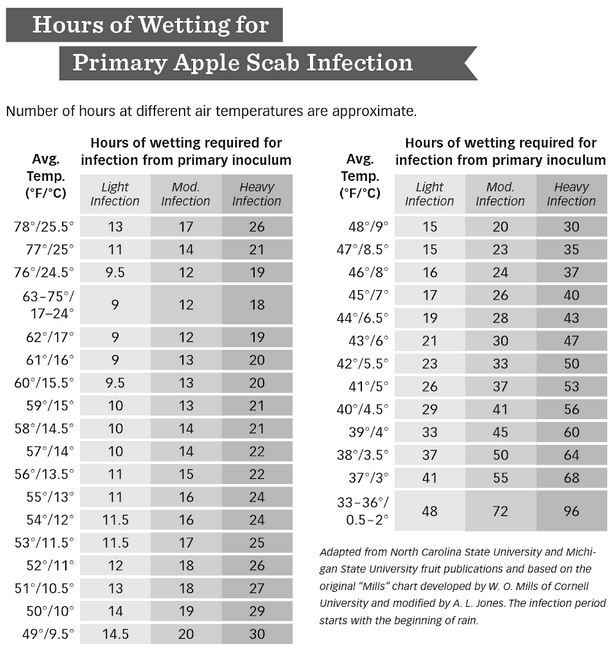Jump-Starting the Apple Scab Management in 2022 – General Strategy and Other Diseases

1. APPLE SCAB. Apple fruit buds on early cultivars in Winchester are at less than 1% Green Tip (Gala, Arlet) and most other apple cultivars are dormant or with some silver tip (ST). Apple scab and cedar-apple rust were visible in some commercial orchards in the Shenandoah Valley last year. Since 2021 was wet and very favorable for apple scab infections, if you had scab showing on leaves and/or fruit in 2021, both early or late in the season, you will need to apply fungicides starting at green tip (GT) and not skip the following applications at 5 to 7 days interval during quarter inch green (QIG), half-inch green (HIG) tight cluster (TC), pink bud (PK), bloom (BL), petal fall (PF) and first cover (FC). Your copper applied from GT to HIG is equal in efficacy to mancozeb. Last year, we had a first major scab infection between HIG and TC (Fig. 1). If you are interested in learning how to use and interpret RIMpro apple scab prediction model, you can e-mail me at: acimovic@vt.edu and I can guide you through subscription process and how to connect a closest NEWA weather station to it. I will be using an e-mail list of subscribers to give you model interpretations weekly. The instructions to subscribe are also listed at the end of this blog post. RIMpro is the best prediction model you can use to determine whether or not the early infection from GT to TC will occur or not. If you did not have scab in your orchard last year, you might not need to apply fungicides and RIMpro can indicate that. If you had visible scab symptoms last year, you should spray for predicted, early-season infection events, that are at or above 100 RIM value (red curves on the graph) (Fig. 1). Farms that had NO scab in the orchard last year, should spray for infection periods at 300 RIM values or above. If you will use only NEWA’s apple scab prediction model, major infection events are when there is >15% ascospore discharge predicted. NEWA scab model is available here: https://newa.cornell.edu/crop-and-pest-management

Figure 1. RIMpro apple scab model output for 2021 in Winchester, VA (historical data from a weather station). White camel hump-like areas labelled “Germinating spores” show cumulative number of Venturia inaequalis ascospores that germinate over time and are read using the right-side vertical Y-axis scale that is labelled “Discharge”. The red curved lines are scab infections. Read each red curve’s peak RIM infection value(s) using the vertical Y-axis scale on the left-hand side of the graph labelled “RIM Infection Value”. Peak RIM value divided by 100 gives you the percentage of the total season’s ascospores that will cause infection for a given infection period (wetting event). Orange area labeled “Primary stroma” represents scab lesions that were initiated by infection from germinating spores and that are incubating in the leaf after which scab lesions will become visible. This is worth knowing because if no fungicide was applied before the infection started, some or all of the incubating infections can be eliminated by using fungicides with post-infection activity. The light red area in the middle graph labeled “Maturation” is the proportion of mature ascospores that are ready for discharge with wetting events whereas the dark red area shows the proportion of immature ascospores still remaining in leaf litter on the orchard floor. The dark blue bars in the bottom graph showing wetting and dates, are the actual rain periods. The light blue bars are actual wetting periods when no rain is falling but trees are still wet after rain. Used by permission of RIMpro B.V., France.
If fire blight was an issue in your orchard in last two years, you should apply delayed-dormant copper spray anywhere from ST to QIG or (HFG), if label permits HIG use for you copper product of choice. Many formulations limit use to QIG as the latest stage you can apply it to avoid phytotoxicity. Copper can reduce bacterial inoculum which reaches bark surface from cankers during warm weather in spring in the form of exuded orange ooze of the bacterium or as ooze-less bacterial colonies. Copper will also affect any apple scab overwintering in buds. If heavy rains are predicted, it is wise to use the high labelled rate of copper for delayed-dormant use, so that residue lasts on the tree through the rain. If fire blight was not an issue in your or any nearby orchards and you do not have fire blight cankers on your trees, you can apply mancozeb instead of copper.
Mancozeb will reduce scab as well as bitter rot or black/white rot inoculum. Scab and bitter rot inoculum can overwinter under the bud scales. However these rots also overwinter in branch/trunk cankers or in fruit mummies left after thinning in the canopy and on the ground. You can mix mancozeb and copper, if necessary. In some years, copper/mancozeb spray at GT to HFG may not be necessary if the weather conditions are cold, which prevents any small amount of released scab ascospores to establish infections. And RIMpro model can indicate this to you by showing only the white humps that are NOT followed by red curve line that rises above 100 RIM value (see an example in Fig. 1 of ascoposre germination of 28 March 2021, that did not lead to infection). Even though omitting this spray application can save you money, many of us still apply copper to cover for fire blight, scab inoculum in buds, and for any low infection events before tight cluster.
The next apple scab spray application(s) are best determined by looking at the RIMpro’s apple scab model predictions (Fig. 2) for a significant infection period. In commercial orchards that did not have scab last year, infection predictions with any red curved line peak at or above 300 RIM value based on the weather forecast, are significant infections. In an example in Figure 2, vertical light blue line separates current day and time within that day, and model outputs to the right of that line (May 6th to 15th) are infection predictions based on weather forecast feeding into the model. The model outputs to the left side of the blue line are actual infections based on the historical weather data provided to the model by the weathers station.

Figure 2. RIMpro apple scab model output showing the vertical light blue line which marks the current date and time within that day. To the right of this light-blue line are model outputs showing infection predictions based on weather forecast feeding into the model. The model outputs to the left side of the light-blue line are actual infections that took place based on the historical weather data fed into the model by the weathers station. Used by permission of RIMpro B.V., France.
For the first major scab infection (HIG to TC) in the spring my recommendation would be to apply anilinopyrimidine (AP) fungicide Vangard (3 oz/A), Scala (5 fl oz/A), or Luna Tranquility (12 fl oz/A) with mancozeb (3 lb/A). AP fungicides work best in cool weather in spring and can be applied before or 72 hr after the time when rain event began and caused scab infection (kick-back activity), however, use kick-back mode of activity only in an emergency i.e. if you know you did not have any fungicide applied before the infection. You can use captan 2.5 lb/A plus mancozeb 3 lb/A instead, before the rain, keeping in mind that both of those fungicides have no kick-back activity and that captan should not be applied anywhere near a past or planned future oil application. Dodine (Syllit) is also an option but is limited to two applications before pink bud (PK), and cannot be used where resistance to dodine is present. Vangard (3 oz/A), Scala (5 fl oz/A), or Luna Tranquility (12 fl oz/A) with mancozeb (3 lb/A) can be applied once more (at TC) and keep in mind that they are not effective for juniper rusts. If weather is cool, and TC extends, gaps can be filled with mancozeb applied alone (3 lb/A). At PK bud, the rust infections will dictate you to switch to more powerful DMI fungicides that control rusts which should also be tank-mixed with mancozeb (3 lb/A). If you had particularly bad powdery mildew last year in the orchard your Luna Tranquility (12 fl oz/A) at TC will be the best choice and should be used instead of Vangard or Scala, as it will control both powdery mildew and scab (it has two components: fluopyram, and pyrimethanil, which is the same active ingredient in Scala). However, at PK bud you will need to apply Rally, Sonoma, Rhyme, Topguard, Indar or Procure with mancozeb which will be great choices and these fungicides will also work well for rusts. For the next major scab infection, at early bloom and/or full bloom, my recommendation will be to use SDHI fungicides (group 7) i.e. either Aprovia, Fontelis, Sercadis, Miravis or Excalia plus mancozeb (3 lb/A). Due to limitation in use of ANY strobilurin fungicides to only 4 applications per year (Group 11, or QoI-s), I would recommend you to NOT use Luna Sensation, Merivon, or Flint for powdery mildew control in spring but to save strobilurins for apple bitter rot control during summer. The SDHI-s I listed above will be effective for powdery mildew, but are not effective for rust control, and that is why mancozeb is tank-mixed with them. At petal fall, I would recommend using Rally, Topguard, Rhyme or Procure plus mancozeb, but if powdery mildew was not an issue last year, you can use Inspire Super plus mancozeb instead which is best option for scab and rust control. Warm wet weather at petal fall can allow Botrytis to infect the dying petals and move from petals into sepals where it can remain quiescent until fruit are moved into storage where the Botrytis can cause gray mold storage decay. Using Inspire Super at petal fall and/or first cover can be the best option because it contains cyprodinil, a fungicide that is effective against Botrytis (if Botrytis is not resistant). Powdery mildew can have an extended infection periods in highly susceptible cultivars until first or second cover, so reserving DMI fungicides for use by second cover in these cases is necessary. If powdery mildew was not an issue last year, Inspire Super plus mancozeb would also be my recommendation for the first cover (10 days after petal fall). If mildew was more a priority for you, use Aprovia, Fontelis, Sercadis, Miravis or Excalia plus mancozeb (3 lb/A). Depending on a year, right before or around first cover primary scab season usually ends, and emphasis shifts more to other diseases.
2. RIMpro SUBSCRIPTION INSTRUCTIONS:
If you do not want to use any digital models, Mills’s scab charts available by clicking here (MacHardy & Gadoury 1989), or presented below in a very simple format and developed by Mills and Laplante (1944, 1951) Modified by Jones /1980/ (Source: Barney D. L. (2012): Storey’s Guide to Growing Organic Orchard Fruits: Market Or Home Production, Storey’s Publishing):

